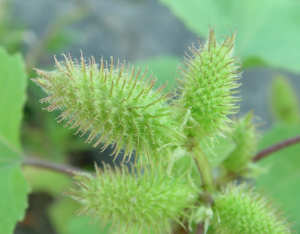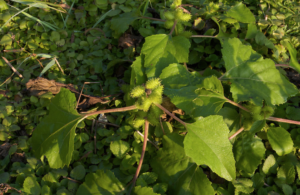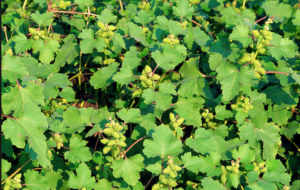Common Name: Beach Clotbur, Rough Cocklebur, Common Cocklebur, Large Cocklebur, Woolgarie Bur
Specific Name: Xanthium strumarium
Known Occurrence at Taylor Point:
Map Areas: Beach 1B
Category: Native, Herbaceous Plant

Ecological Considerations:
Xanthium strumarium, commonly known as Beach Clotbur is a summer annual that grows to about 2-4 feet tall. It is branched, except for short side stems developing from the leaf axils. The stems are round or slightly ribbed and often are speckled with purple and have short white hairs scattered across the surface.
The alternate leaves are up to 8″ long and 6″ across. Their margins are shallowly lobed or coarsely toothed, while the upper surface has a sandpapery texture. Each leaf has a long petiole that is often reddish or reddish green and about as long as the leaf blade. The petioles usually have short white hairs.
A single spike-like raceme of compound flowers develops from the axil of each upper leaf. These racemes are shorter than the petioles of the leaves, often 1-4 inches in length. In addition, the central stem terminates in a spike-like raceme that is similar to the racemes of the leaf axils. Because Beach Clotbur is monoecious, each raceme produces several male compound flowers along its upper half, while several female compound flowers occur in the lower half.
The blooming period for Beach Clotbur occurs during the late summer or early fall, although some plants may bloom a little earlier or later. These plants are pollinated by wind. The flowers have no scent. Each female flower within the bur-like bract produces a single oblong seed that more or less tapers to a point at each end. The seeds are often covered with dark membranes. One of the seeds in each bur has the capacity to germinate the following year, while the the germination of the second seed is delayed for at least 2 years. The root system consists of a taproot that is stout and rather woody. This plant reproduces by reseeding itself, and often forms colonies.
A Clotbur was the inspiration for a Swiss engineer, George deMastral, in 1948, for the invention of Velcro. He examined the burs that stuck to his socks and discovered that they consisted of hundreds of tiny hooks, which attached themselves to anything loopy.
Map areas where this plant can be used for revegetation:
Propagation Mechanisms/Strategies for Encouraging its Establishment:
The flowerheads of the Beach Clotbur rely on the wind, rather than insects, to cross-pollinate.Because the burry fruits readily cling to the fur of mammals and the clothing of humans, they are easily transported to new areas, spreading the seeds of this plant.
Best Planting Practices/Options and Pros and Cons of Options:
Key Issues Regarding its Ecology:
Associated Ecological Benefits:
A variety of insects including beetles and beetle larvae and aphids feed on Beach Clotbur. White-tailed Deer sometimes consume the upper half of mature plants before the bur-like flowers develop.
Availability of Locally Sourced Seeds and Plants:
Case Studies of Native Plant Establishment Efforts/Lessons Learned:
Additional Photos:



Sources cited:
Wildflower.org
Illinois Wildflowers
Key Words:
Xanthium strumarium
Beach Clotbur
Rough cocklebur
Common Cocklebur
Large Cocklebur
Woolgarie Bur
Beach 1B
